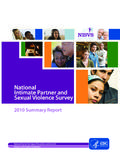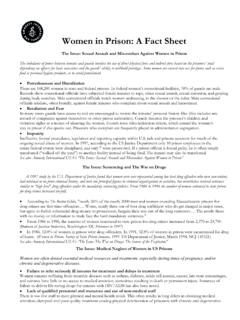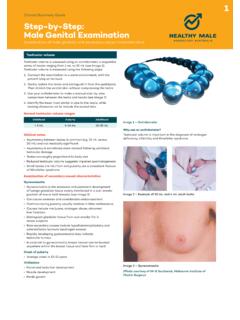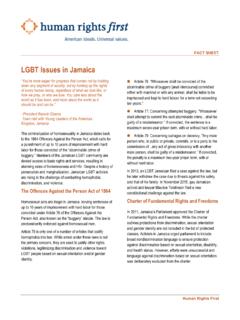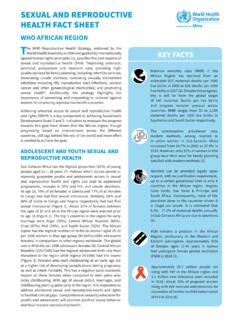Transcription of Estimated HIV incidence and prevalence in the United ...
1 Volume 26,Number 1 Estimated HIV incidence and prevalence in the United States, 2015 2019 HIV Surveillance Supplemental Report2 Vol. 26, No. 1 This issue of the HIV Surveillance Supplemental Report is published by the Division of HIV/AIDS Prevention, National Center for HIV/AIDS, Viral Hepatitis, STD, and TB Prevention, Centers for Disease Control and Prevention (CDC), Department of Health and Human Services, Atlanta, Georgia. Estimates are presented for the incidence and prevalence of HIV infection among adults and adolescents (aged 13 years and older) based on data reported to CDC through December HIV Surveillance Supplemental Report is not copyrighted and may be used and reproduced without permission.
2 Citation of the source is, however, citationCenters for Disease Control and Prevention. Estimated HIV incidence and prevalence in the United States, 2015 2019. HIV Surveillance Supplemental Report 2021;26(No. 1). Published May 2021. Accessed [date].On the Web: information, referrals, and educational material on HIV infectionCDC-INFO1-800-232-4636 (in English, en Espa ol)1-888-232-6348 (TTY) of this report was made possible by the contributions of the state and territorial health departments and the HIV surveillance programs that provided surveillance data to report was prepared by the following staff and contractors of the Division of HIV/AIDS Prevention, National Center for HIV/AIDS, Viral Hepatitis, STD, and TB Prevention, CDC: Laurie Linley, Anna Satcher Johnson, Ruiguang Song, Sherry Hu, Baohua Wu, H.
3 Irene Hall, Angela Hernandez, and Michael Friend and the Web and Consumer Services Team of the Prevention Communications Branch (editing and desktop publishing). HIV Surveillance Supplemental Report3 Vol. 26, No. 1 ContentsContentsCommentary4 Suggested Readings10 Technical Notes11 References16 TablesSection 1 Estimated incidence of HIV Infection among Persons Aged 13 Years1 Estimated HIV incidence among persons aged 13 years, by year of infection and selected characteristics, 2015 2019 United States172 Estimated HIV incidence among Black/African American persons aged 13 years, by year of infection, sex at birth, and selected characteristics, 2015 2019 United States203 Estimated HIV incidence among Hispanic/Latino persons aged 13 years, by year of infection, sex at birth, and selected characteristics.
4 2015 2019 United States234 Estimated HIV incidence among White persons aged 13 years, by year of infection, sex at birth, and selected characteristics, 2015 2019 United States265 Estimated HIV incidence among men who have sex with men, by year of infection, race/ethnicity, and age at infection, 2015 2019 United States296 Estimated HIV incidence among persons aged 13 years, by year of infection and area of residence at diagnosis, 2015 2019 United States and Puerto Rico34 Section 2 Estimated prevalence of HIV Infection among Persons Aged 13 Years7 Estimated HIV prevalence and undiagnosed infection among persons aged 13 years, by selected characteristics, 2019 United States398 Estimated HIV prevalence among persons aged 13 years, by year and selected characteristics, 2015 2019 United States409 Estimated HIV prevalence among Black/African American persons aged 13 years, by year, sex at birth, and selected characteristics, 2015 2019 United States4510 Estimated HIV prevalence among Hispanic/Latino persons aged 13 years, by year, sex at birth, and selected characteristics, 2015 2019 United States5011 Estimated HIV prevalence among White persons aged 13 years, by year, sex at birth, and selected characteristics.
5 2015 2019 United States5512 Estimated HIV prevalence among men who have sex with men, by year, race/ethnicity, and age, 2015 2019 United States6013 Estimated HIV prevalence among persons aged 13 years, by year and area of residence, 2015 2019 United States and Puerto Rico65 Appendix: Estimates of incidence and prevalence for Ending the HIV Epidemic Initiative Phase I JurisdictionsA1 Estimated HIV incidence among persons aged 13 years, by year of infection and area of residence at diagnosis, 2017 2019 Ending the HIV Epidemic Initiative Phase I jurisdictions70A2 Estimated HIV prevalence among persons aged 13 years, by year and area of residence, 2017 2018 Ending the HIV Epidemic Initiative Phase I jurisdictions76 HIV Surveillance Supplemental Report4 Vol.
6 26, No. 1 CommentaryThe primary goal of the initiative, Ending the HIV Epidemic: A Plan for America (EHE), is to reduce the annual number of new HIV infections by 75% in 5 years and by at least 90% in 10 years [1]. A key objec-tive to reaching this goal is to increase the percentage of persons with HIV who are aware of their infection [2]. Persons who are aware of their HIV infection can be linked to care and receive treatment to reduce mor-bidity and viral load levels, making them less likely to transmit the virus to others [3]. Estimates of (1) HIV incidence , (2) prevalence (persons living with diag-nosed or undiagnosed HIV infection), and (3) percent-age of diagnosed infections among persons living with HIV (percentage of persons living with HIV who are aware of their infection) are essential to determining whether prevention program efforts are reducing the annual number of new HIV infections ( incidence ) and achieving prevention measures the number of infections during a specified time ( , year).
7 These estimates can be used to assess changes in characteristics of persons with newly acquired HIV infection. Diagno-ses refer to persons who may have been infected years before refers to the number of persons living with HIV disease at a given time regardless of the time of infection or whether the person has received a diagnosis. prevalence and the percentage of diag-nosed infections among persons living with HIV reflect the number of persons in need of care and treatment services for HIV produce the HIV incidence and prevalence esti-mates in this report, we used the result of the first CD4+ T-lymphocyte (CD4) test after HIV diagnosis and an estimation method based on a CD4 depletion model (referred to hereafter as the CD4 model ) [4 7].
8 The first CD4 test results after HIV diagnosis are routinely collected by all jurisdictions as part of the National HIV Surveillance System (NHSS). CD4 MODELCD4 cells, a type of white blood cell, aid in fighting infections. HIV targets CD4 cells: without treatment, HIV reduces the number of CD4 cells in a person s body. A person s CD4 cell count is used to determine stage of disease. Assuming that no treatment has been received, the CD4 cell count can be used to estimate the time since infection at the date of CD4 test. We applied the CD4 model to NHSS data, Estimated the distribution of delay from infection to diagnosis, and then produced national and jurisdiction-level esti-mates of HIV incidence and prevalence among adults and adolescents.
9 Reporting of the first CD4 test result after diagnosis of HIV infection is a required data ele-ment on the HIV case report form. By December 2020, a CD4 test result had been reported to NHSS for of persons with HIV diagnosed during 2015 2019. Completeness of reporting varied among states and local CHANGESCDC has updated the methods for producing inci-dence and prevalence estimates (see Technical Notes for additional information). This report is based on data reported to NHSS through December 31, 2020 to allow for a 12-month reporting delay. prevalence esti-mates for the year 2019 are preliminary and based on death data received by CDC as of December 2020.
10 prevalence trends through 2019 should be interpreted with caution. The following jurisdictions had incom-plete reporting of deaths for the year 2019 and associ-ated prevalence estimates should be interpreted with caution: Kansas, Massachusetts, Mississippi, Nevada, North Dakota, and FORMATAll numbers and percentages in this surveillance supplemental report (except numbers of diagnosed cases) were Estimated by using the CD4 model. Not all percentages mentioned in the text are displayed in the tables are organized into 3 sections:1. Estimated incidence of HIV infection among adults and adolescents (Tables 1 6)2. Estimated prevalence of HIV infection among adults and adolescents (Tables 7 13)3.











